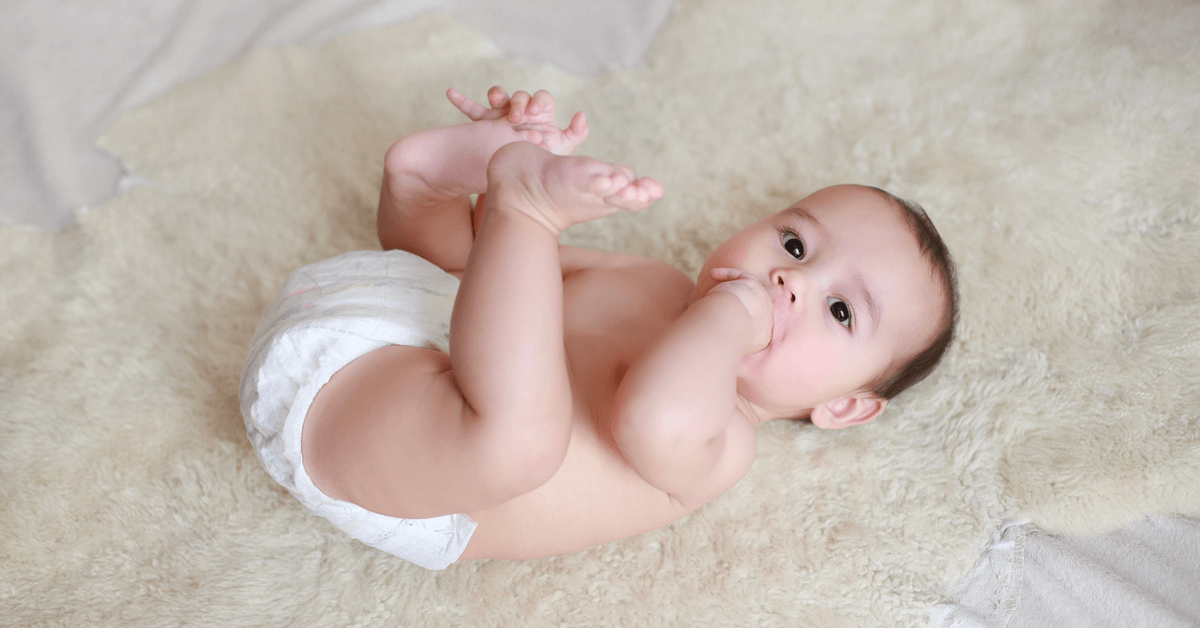First Checkups for 1-Month-Old (Newborn) Baby
Your doctor will do another general examination within the first 24 hours after the first postnatal examination. What is examined in this examination? Let’s take a look together.
- Baby’s weight (decreased by 10% after birth, don’t worry)
- Head circumference and height
- Red highlight in the eye (light beam hitting the back wall of the eye and coming back)
- Heart sounds and breathing
- Palpation (external manual) examination of internal organs such as kidney, liver, spleen
- newborn reflexes
- Hips (to check for dislocations)
- Hands, feet, arms, legs, genitals
- Remainder of the umbilical cord
What Can Your Baby Be Doing in 1-Month?
At the end of the 1st month, your newborn baby:
- Can lift head briefly when laid on a flat surface
- Can focus on a face
- Responds to the rattle in some way (crying or calming down)
- Can follow an object moved in an arc 15 cm above the face beyond the midline
- Can make sounds other than crying
- He can respond to your smile with a smile
- May start laughing spontaneously
If your newborn cannot do one or more of these, it would be beneficial to talk to your doctor about this issue. Usually, a return to normal is observed afterwards.
Keep in mind that premature babies reach this maturity later than average babies.
1-Month-Baby Nutrition – What Should a Newborn Baby Eat?
Breast milk is the most important and most suitable food for your baby. It is always fresh, clean and ready to be given to the baby, so breastfeeding is a cheap and straightforward method. Even the healthiest food produced cannot be developed in a way that can imitate breast milk. Breast milk meets all your baby’s needs for the first six months. It protects your baby from all diseases and strengthens your emotional bond.
Tips for Successfully Breastfeeding Your Baby
- Reduce the crowd in the room. You and your baby should concentrate on breastfeeding sessions during these early periods and have a few guests as possible.
- Change diapers. Once your baby has calmed down a bit, it’s time to make a change. A clean diaper makes feeding time more comfortable and eliminates the need to change diapers right after. However, do not change diapers at night unless necessary; this type of intervention makes it difficult for the baby to go back to sleep.
- Find a comfortable position. Muscle aches and widespread body aches can be occupational diseases for new parents carrying a growing baby. Feeding the baby in an awkward position exacerbates the problem. Before breast or bottle-feeding the baby, try to ensure your comfort by providing adequate support for your back and under the arm under the baby.
- Comfort the baby. If you have wrapped the baby too tightly, loosen it during feeding.
- Calm the screaming baby. This way, the baby cannot concentrate on sucking. Try singing a soft song or rocking it a little. Even if your voice is terrible, don’t mind it!
- Contact your baby. Hug and caress your baby with your hands, eyes and voice. Remember that meals meet your baby’s daily nutritional needs and their mother’s love needs.
- Take a burping break. Give your baby regular burping breaks when changing a breast or when the bottle is halfway. If your baby stops feeding prematurely, retake a burping break. You ask why? It’s pretty simple. It may be gas, not food, that fills your baby’s tiny tummy.
Over time, your baby’s sucking may change. The baby, fed every 3-4 hours before, may want to breastfeed more or less frequently over time. Don’t let this worry you. Do not think that your milk is low or out. Contrary to a well, the milk reserve does not dry out with regular use. Your breast produces milk as your baby suckles. The event that makes your baby turn to your breast more often is growth or increased appetite.
Appetite increase is most common in the third week, sixth week and third month.
Sometimes the baby, who slept at night, wants to wake up and suckle because his growth accelerates. In this case, the active appetite of the baby will meet his needs by constantly increasing the milk production in the mother. In such cases, relax and respond to your baby’s needs.
Do not start giving the formula to satisfy the baby’s appetite because suddenly stopping breastfeeding will reduce the amount of milk, and the baby will turn to the bottle, which will be easier to feed. If you have to go back to work, that means you won’t be able to breastfeed for 8-10 hours. This reduces your milk production. The way to prevent this is to express your milk at least every 3 hours when the baby is not with you.
1-Month(Newborn)-Baby Care
Bathing a 1-Month-Old Baby
Daily bathing is not necessary unless the baby is completely soiled. It is enough for him to do local cleaning during a diaper change and after feedings. If your baby likes a bath, you can wash it every day. Babies who don’t like baths can be bathed two or three times a week. Daily wiping the critical areas (face, neck, head, butt) with a sponge is good during baths.
Any time of the day may be suitable for bathing, but a bath before bedtime helps the baby relax and forms the stage of preparation for sleep. The little ones who have insomnia problems, come to the bathroom!
By the way, keep in mind, never give your baby a bath right before or after meals.
Consider the possibility that bathing with a full stomach could make the baby vomit. The baby may not want to take a bath even when hungry. In this case, leave him alone, never force him. Give enough time to the bathroom. In this way, you will not be in a hurry, and you will not leave the baby idle for a second while taking a bath.
Get a portable baby tub. Don’t let your workspace limit you while bathing the baby. For the baby’s comfort, turn off all fans and air conditioners while taking a bath, especially in the first months; make sure the room is warm.
What to Do in Case of Fever?
Many things can cause a fever in your baby. When this happens, you first need to observe your baby well. When a baby under three months of age develops a fever, you should always consult a doctor as soon as possible, as there is a high risk of febrile convulsions. Never give your baby any medicines without consulting with your doctor first. Suppose your baby continues to feel uncomfortable, even if the fever has decreased. In that case, we recommend that you also consult with your doctor. After three months, depending on the duration and height of the fever, you may wait a little longer before taking your baby to the doctor.
When Should a 1-Month-Old Baby Be Bathed?
So when is your baby ready for a tub bath? Here’s the answer: After the umbilical cord heals, your baby is ready for a tub bath. This means 1-4 weeks after birth. If your baby doesn’t like to be in the water, it would be beneficial to wipe it with a sponge for a few more days.
How to Wash a Baby?
- Before washing the baby, make sure that the temperature of the water is appropriate and that you hold it tight to relieve the baby’s innate fear of falling.
- Put about 5 cm of water in the baby tub and control the water temperature with your elbow.
- Do not put soap or bubble bath in the tub as these can dry out your baby’s skin.
- After completely undressing your baby, slowly submerge them in water and hold them tight to avoid the startle reflex.
- Gently soap your baby with baby soap, starting with the dirtiest parts.
- Use separate sterile cotton pads for the baby’s eyes. Then rinse your baby with a clean washcloth.
How to Remove Gas in Babies?
Of course, it’s not just milk that your baby swallows while breastfeeding from the breast or bottle. Along with the nutritious liquid, he eats air, and when the baby completes his meal, he may be uncomfortable with this gas. For this reason, burp the baby every 5 minutes while breastfeeding or occasionally while feeding with a bottle. There are three ways to do this:
- Put it on your shoulder.
- Lay it on your lap face-to-side.
- Sit upright.
You can try them all and find out which is the best way.
Light strokes or back rubs are enough to burp most babies. However, some may require more vital touches.
If you wish, let’s learn together how to apply the techniques:
- Resting on your shoulder: Hold the baby firmly on your shoulder and grab the bottom with one hand and gently pat the back with the other. This is the grip that works best for most babies. But don’t forget to protect your shoulder with a clean towel.
- Laying the baby on your lap with their side to the side: Lay the baby on your lap with their tummy on top of your other leg, face sideways on one leg. Grasp the baby firmly with one hand and gently pat the back with the other.
- Sitting upright: Sit your baby on your lap with the head tilted forward and support the chest area with one hand while holding the baby under the armpit. Rub the baby’s back like this.
How to Diaper a 1-Month(Newborn)-Old Baby?
Especially in the first months, your baby needs frequent diaper changes. Although it can be a chore for both your baby and you, it is good to change diapers before and after meals. Thus, you can prevent diaper rash and irritation on your baby’s sensitive bottom.
There’s no need to pick up your sleeping baby to change the baby’s diaper, and there’s no reason to change diapers during overnight feedings unless the baby is very wet and uncomfortable. If you do, your baby’s sleep may be interrupted, and it may be difficult to fall asleep again.
Things to consider when changing your baby’s diaper:
- Make sure you have everything you need at hand. (clean cloth, wet wipe, drying towel, clean wet cloth)
- Wash your hands before changing diapers
- Put a protective cover called a baby care mat or changing mat under your baby and never leave your baby alone while changing the diaper.
- Untie the baby’s diaper. If there is a stool, clean it with a diaper. Clean the front of the doll with hot water or cleaning cloth, trying to reach all the folds.
- Then lift her legs and clean her butt; slide the soiled cloth out from under the baby and place the clean cloth under it. If you have used water, dry the baby with a soft towel.
Baby Nail Trimming – How to Cut Nails?
Cutting a newborn baby’s nails worries most mothers. Or do you think so? But you have to do this at the risk of the baby scratching his face. Cutting your baby’s nails is as easy as cutting paper. The tricky thing is to keep the baby in a fixed position while cutting nails. If the baby is a deep sleeper and you are not afraid to wake the baby, try to trim your baby’s nails during sleep. If the baby is awake, have someone hold the baby while you cut their nails.
Always use round-tipped nail clippers for babies. If you can’t use a cutting tool as a last option, you can cut the mother’s teeth and the baby’s nails.
Baby Umbilical Cord Care
When does the baby umbilical cord fall off? The answer to the question: A few days after birth, the cord residue darkens and falls off after 7-10 days. Accelerate healing by ensuring that the area is ventilated and dry. Things to consider to prevent the area from becoming infected:
- While diapering the baby, fold the front of the diaper down to allow the area to breathe and prevent contact with urine.
- Do not bathe in the tub, and do not wet the navel until the cord falls off.
- Wipe the cord with alcohol. This keeps the cord clean and dry.
- Consult a doctor if the area around the navel becomes red or has a leak.
Use antiseptics containing iodine by asking your doctor because the iodine in these substances can be absorbed through the skin and suppress thyroid (goitre) hormones.
Baby Health and Development Review
In general, at the first check-up when your baby is two to four weeks old, the following should be noted:
- Baby’s nutrition, sleep, general development are examined
- Measure baby’s weight, height, head circumference
- Sight and hearing examination is done
- A general physical examination of the baby is done
- Umbilical cord healing is checked
- Baby’s age-specific reflexes are checked
- The fontanelles are palpated
- Your doctor will make recommendations about vitamin D.
It’s Your Turn Now – Write a Comment
How are you raising your one-month-old baby? What challenges did you experience? How did you overcome them? We welcome your comments so that other caregivers can learn.
Don’t Forget to Share!
Don’t forget to share our one-month-old baby development article so other caregivers and expectant parents can read and learn!







